Recordings
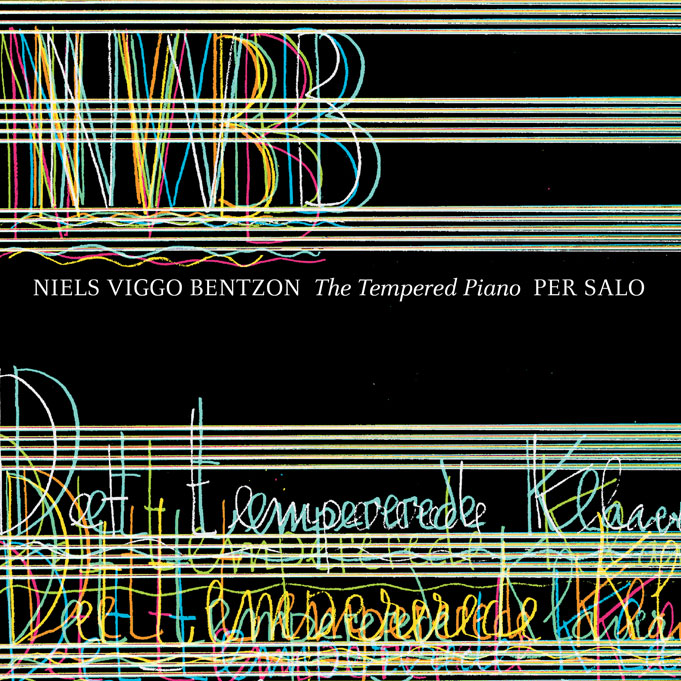
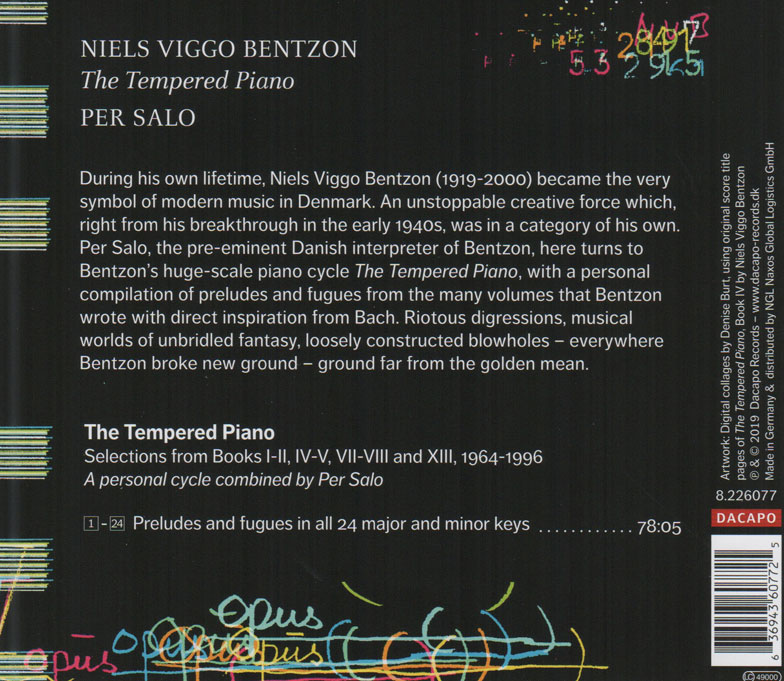
Niels Viggo Bentzon The Tempered Piano
Per Salo, klaver
Dacapo 2019
During his own lifetime, Niels Viggo Bentzon (1919-2000) became the very symbol of modern music in Denmark. An unstoppable creative force which, right from his breakthrough in the early 1940s, was in a category of his own. Per Salo, the pre-eminent Danish interpreter of Bentzon, here turns to Bentzon’s huge-scale piano cycle The Tempered Piano, with a personal compilation of preludes and fugues from the many volumes that Bentzon wrote with direct inspiration from Bach. Riotous digressions, musical worlds of unbridled fantasy, loosely constructed blowholes – everywhere Bentzon broke new ground – ground far from the golden mean.
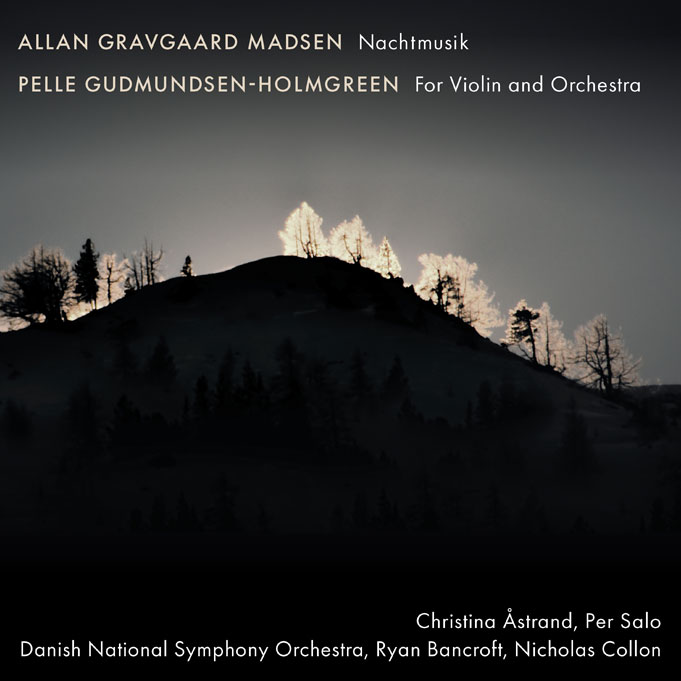
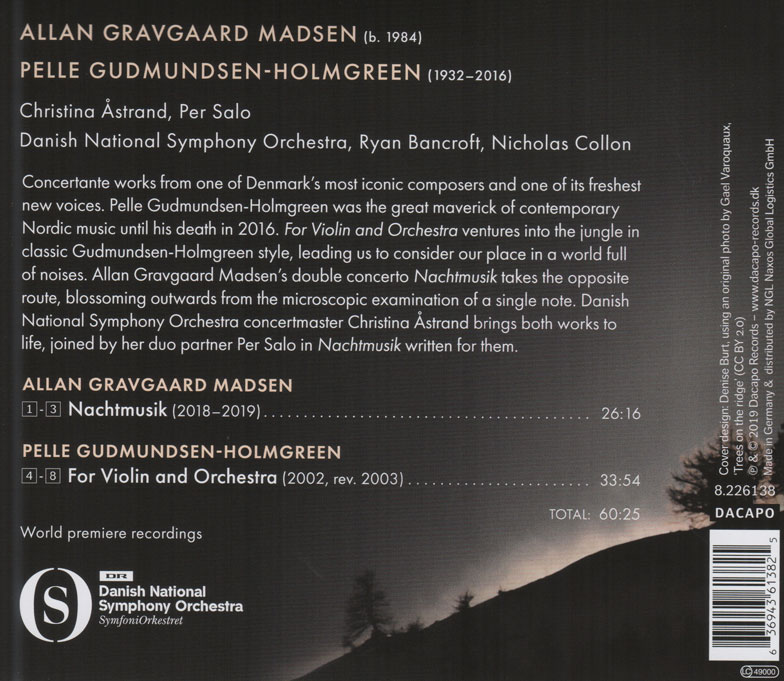
Allan Gravgaard Madsen Gudmundsen-Holmgreen Nachtmusik - for Violin and Orchestra
Christina Åstrand, violin. Per Salo, piano.
Danish National Symphony Orchestra, Ryan Bancroft, Nicolas Collon
Dacapo 2019
Allan Gravgaard Madsen’s brand new double concerto for violin and piano greets the night starting with one single note which in the course of the movement unfolds into cascades of harmonies throughout the entire orchestra. Pelle Gudmundsen-Holmgreen was the maverick of contemporary Nordic music until his death in 2016. The violin concerto For violin and orkester ventures into the jungle in the classic Gudmundsen-Holmgreen-style forcing us to reassess our place in a world full of noises.
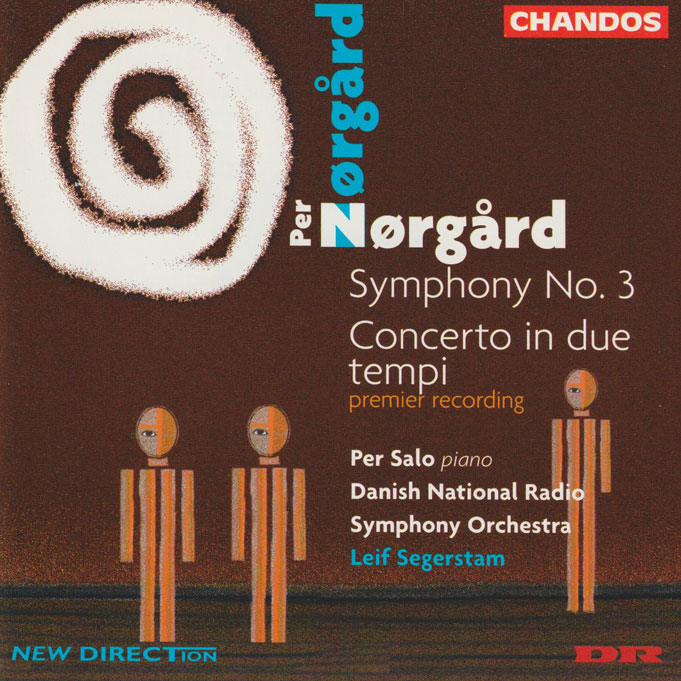
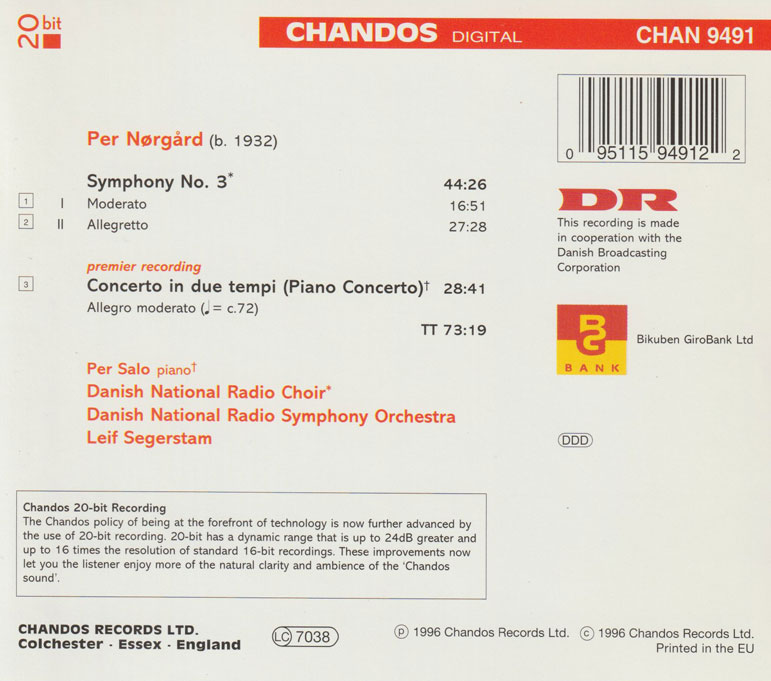
Per Nørgård - Piano Concerto Concerto in Due Tempi - Symphony Nr 3
Per Salo, piano.
Danish National Symphony Orchestra, DR Concert Choir, Leif Segerstam.
Dacapo 2008
The two tempi of the concerto’s title do not refer to two separate movements but to two tempi constantly alternating and finally metamorphosing into two new tempi. The piano concerto is quite different from Nørgård’s previous solo concertos. Melodically and harmonically the piano concerto is one of his most easily accessible works. Symphony nr 3 from 1976 for orchestra and choir has become one of Nørgård’s signature works; the composer’s compositional principle of the infinity series plays an important part in creating the staggering harmonic structures of the symphony.
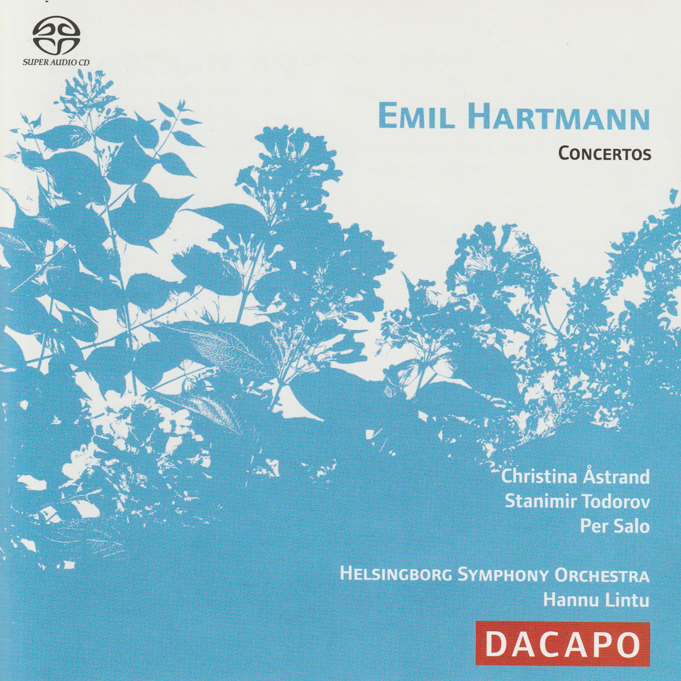
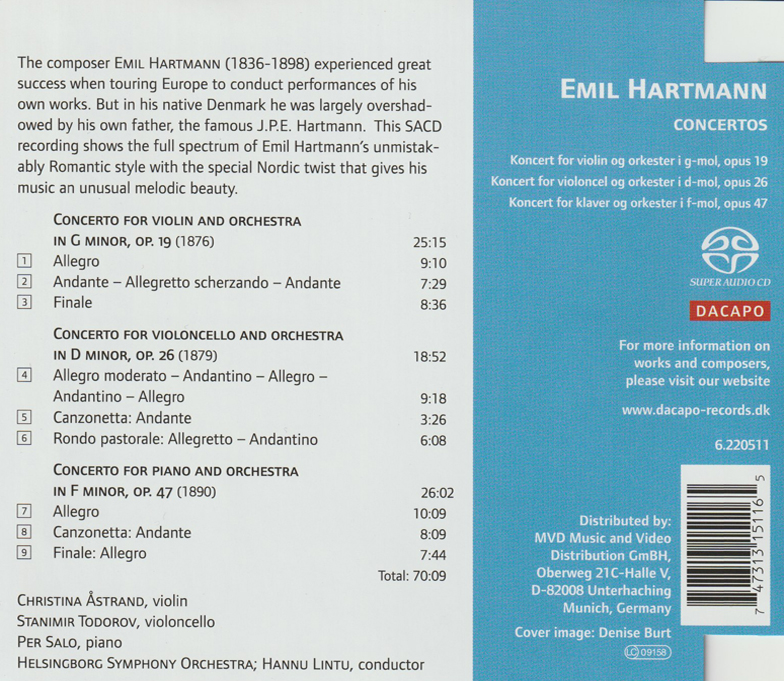
Emil Hartmann Violin Concerto, Piano Concerto and cello Concerto
Christina Åstrand, violin. Per Salo, piano. Stanimir Todorov, cello.
Helsingborg Symphony Orchestra. Hannu Lintu.
Dacapo 2005.
Emil Hartmann (1836-1898) experienced great success when he toured Germany and the rest of Europe conducting his own works, and was often compared to the great Romantic masters of the European musical scene. But at home in Denmark the composer was overshadowed throughout his life by his famous father J.P.E. Hartmann. The writer Hans Christian Andersen actually said of the two Hartmanns that old Hartmann is a born composer, young Hartmann was brought up to it. With this recording of Emil Hartmann's three concertos - for violin, cello and piano - we can be in no doubt that the fame that Emil Hartmann enjoyed abroad was more than deserved.
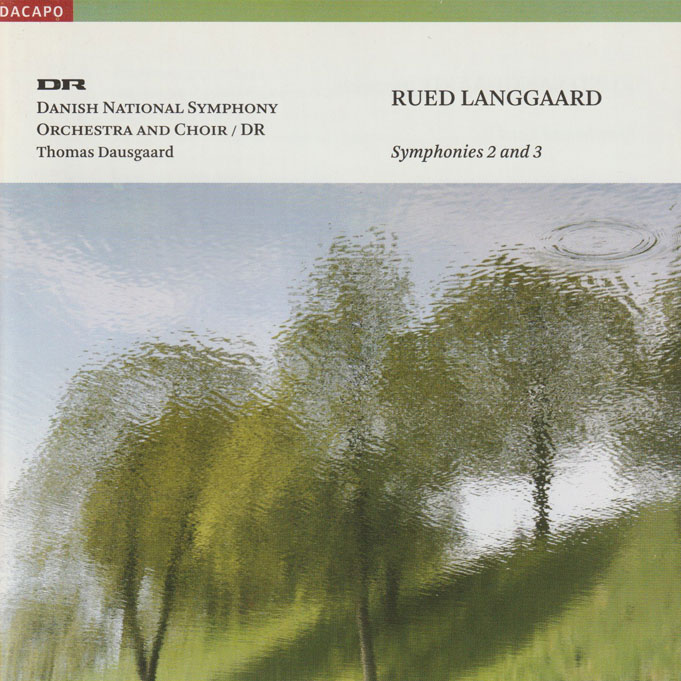
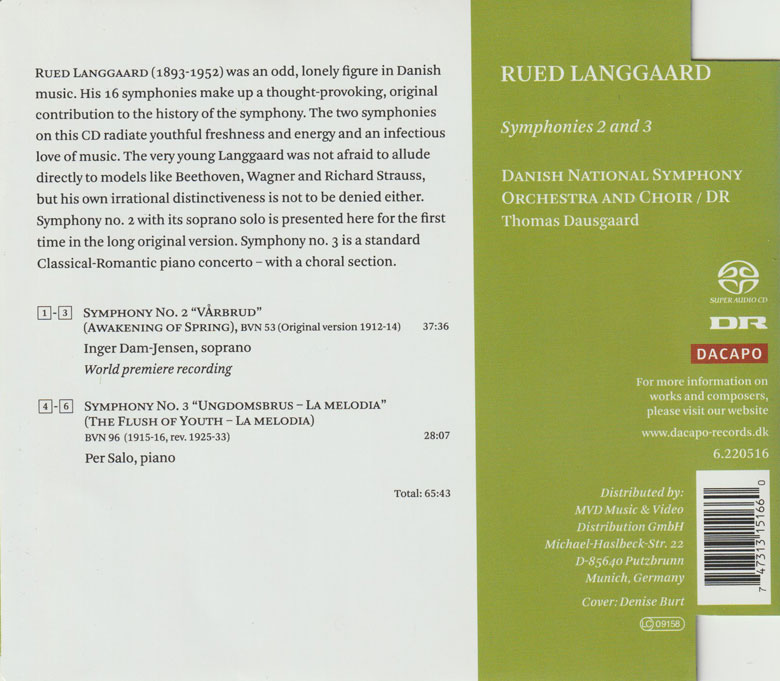
Rued Langgaard - the Flush of Youth Symphony Nr 3 for Piano and Orchestra Symphony Nr 2 Awakening of Spring
Per Salo, piano. Inger Dam Jensen, soprano.
Danish National Symphony Orchestra, Thomas Dausgaard.
Dacapo 2007
Rued Langgaard (1893-1952) was an odd, lonely figure in Danish music. His 16 symphonies make up a thought-provoking, original contribution to the history of the symphony. The two symphonies on this CD radiate youthful freshness, courage and the infectious joy of music-making. The very young Langgaard was not afraid to refer directly to ideals like Beethoven, Wagner and Richard Strauss, but his distinctively irrational features were not to be denied either. Symphony No. 2 with soprano solo is presented here for the first time in the long original version. Symphony no. 3 is a true Classical-Romantic piano concerto - with a choral section.
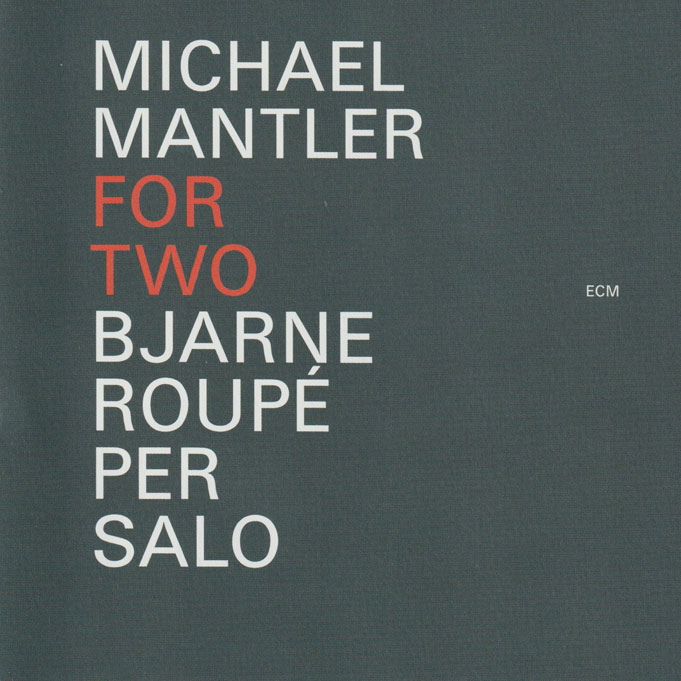
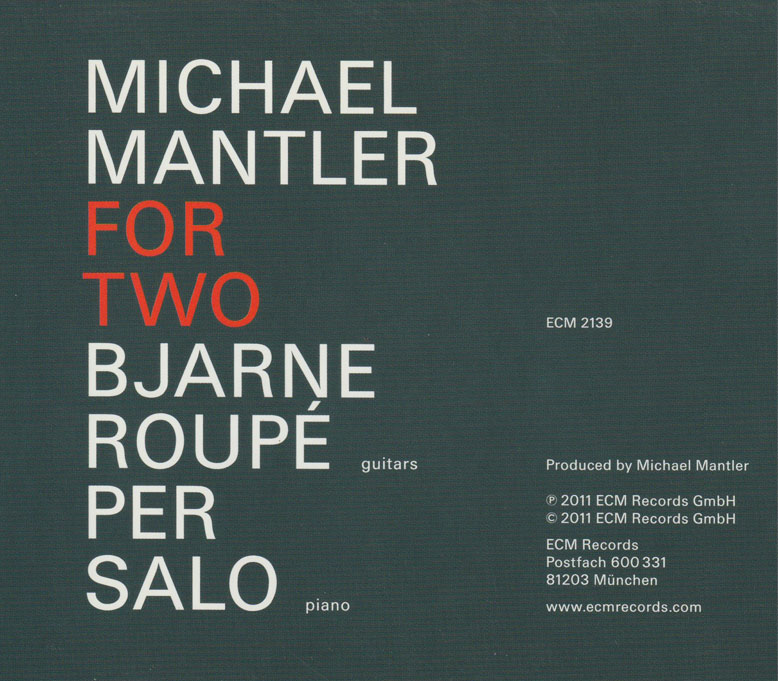
Michael Mantler For Two
Bjarne Roupé, guitar.
Per Salo, piano.
ECM 2011
The concise and relatively short pieces featured on this recording continue Michael Mantler’s basic concept of creating music that is in part completely notated, but also involves improvisation. It is here reduced to a minimum, possibly his simplest and most economic interpretation of that idea so far, with only two instruments: the piano representing his basically orchestral compositional concept with a soloist from contemporary new music (a “classical” non-improvising pianist), combined with a second player coming from jazz, the guitarist (improvising and freely interpreting).
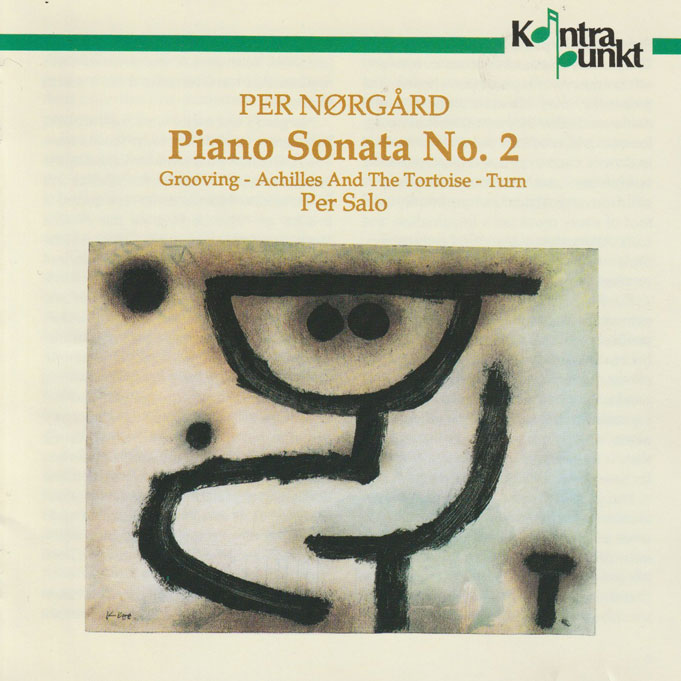
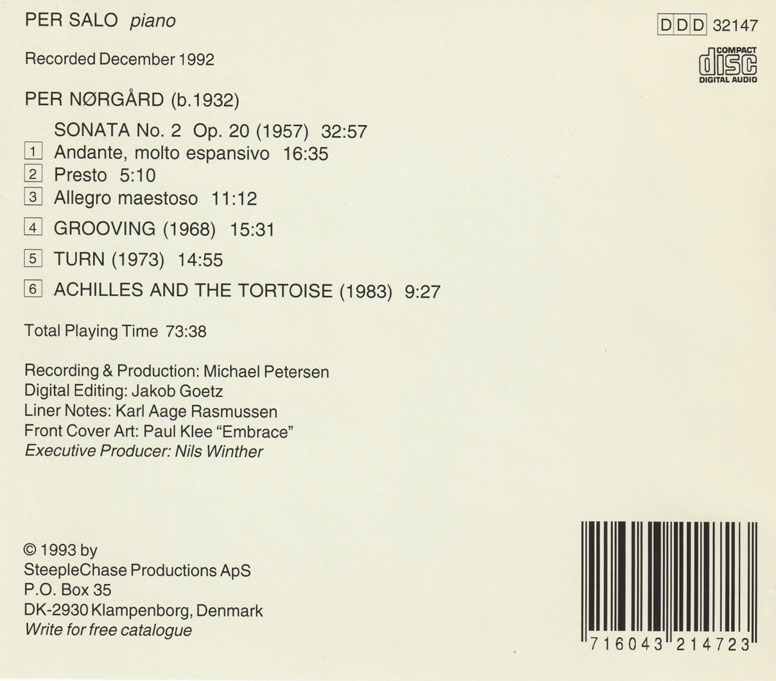
Per Nørgård: Piano Works Sonata Nr 2, Grooving, Turn, achilles and The Tortoise
Per Salo, piano.
Kontrapunkt 1993
Per Nørgårds fascination for the piano and its possibilities have fascinated him ever since his early youth. Even though his piano compositions do not dominate the list of his works, he has often discovered and crystalized new stylistic expressions at the piano and his piano works have often shown themselves to be direction finders for new developments.
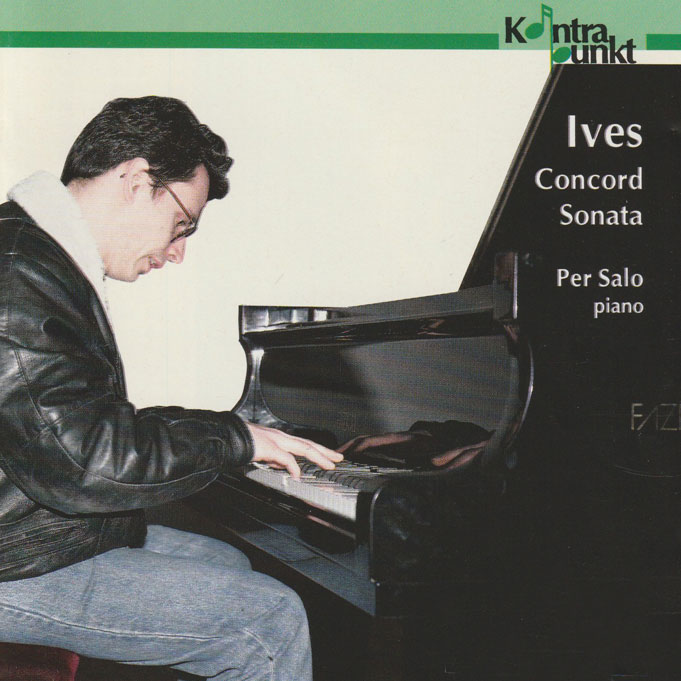
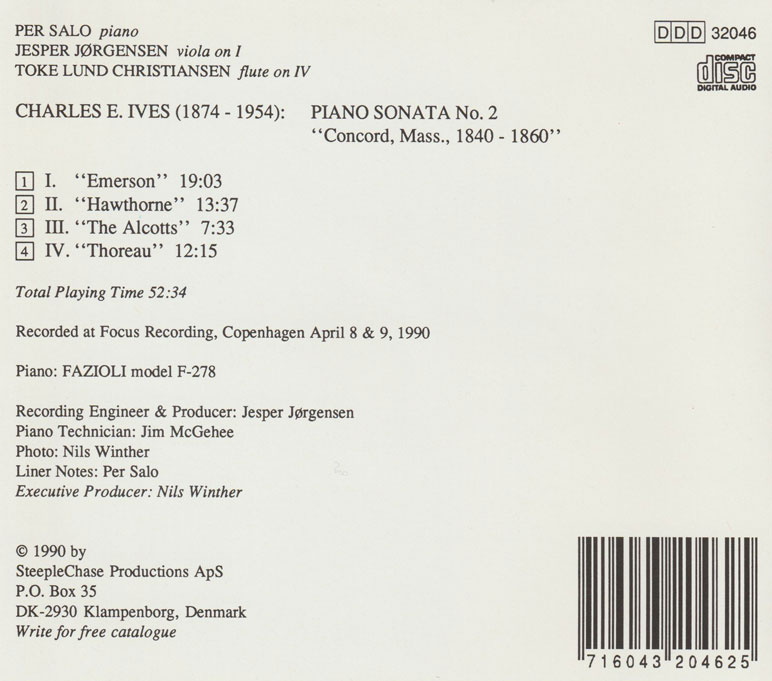
Charles Ives: Concord Sonata “(Concord Mass. 1840 - 1860)"
Per Salo, piano.
Kontrapunkt 1990
The sonata was composed, or more exactly recomposed, in 1911-15. Emerson, Hawthorne and The Alcotts, the titels of the three first movements, were conceived as orchestral works and were originally meant to be parts of Ives´ projected series Men of literature Ouvertures. But in 1911-15 he recomposed the unfinished orchestral scores into his second piano sonata and added the Thoureau movement.
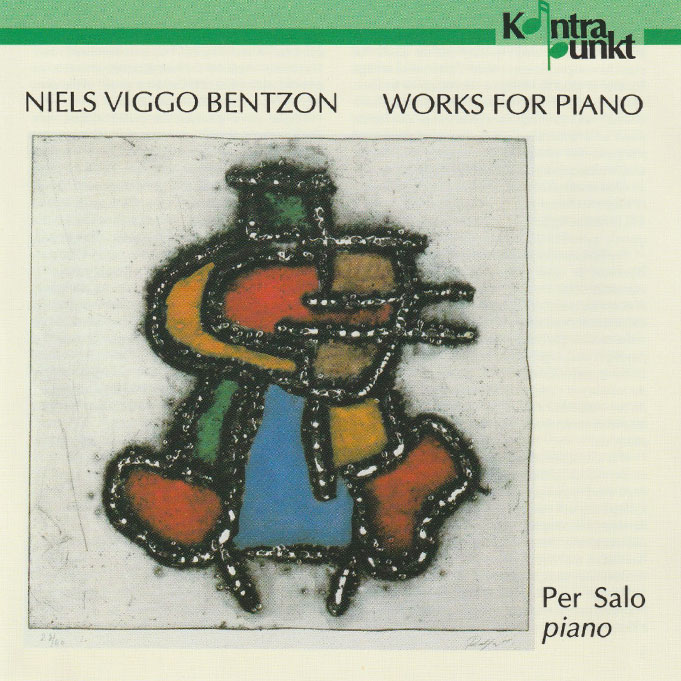
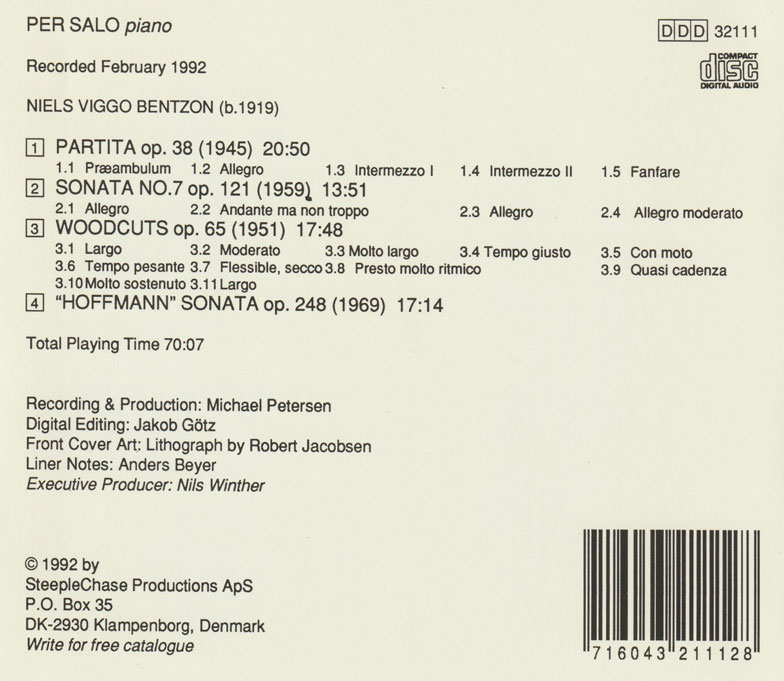
Niels Viggo Bentzon Partita, Sonata 7, Woodcuts, Hoffmann Sonata
Per Salo, piano.
Kontrapunkt 1992
Looking at Niels Viggo Bentzon´s comprehensive production, one realizes quickly that the piano works have a specific importance. This is only natural because in order to introduce the composer Bentzon you cannot possibly ignore the pianist Bentzon. The composer has a pronounced love for the piano as musical medium. This combination of composer and interpreter is expressed in a totally unique musical landscape where the two worlds meet in a succesful synthesis of system and freedom; the composer’s need to control the material and the pianist’s urge to play freely with the material, generate a music that subsequently could be described as a “frozen improvisation”.
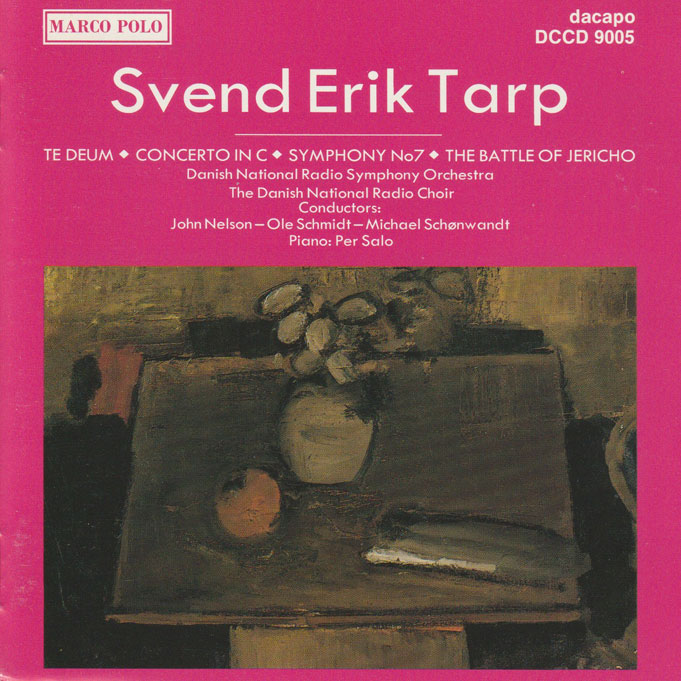
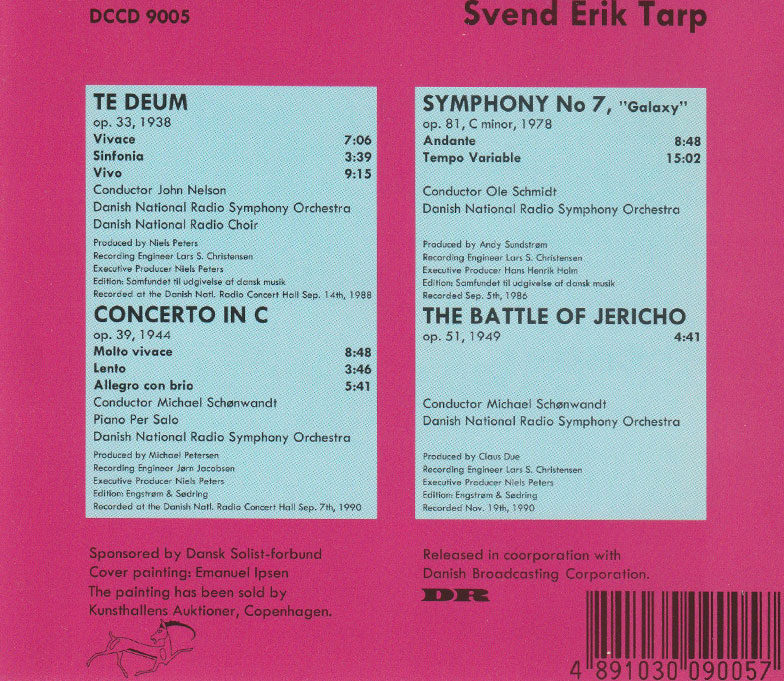
Svend Erik Tarp Piano Concerto in C Symphony Nr 7 - Te Deum
Per Salo, piano.
DR Concert Choir, Danish National Symphony Orchestra
Michael Schønwandt, Ole Schmidt, John Nelson
Dacapo 1992
A rare recording of works by Danish composer Tarp whose music is predominately neo-classical but even shows some romantic traces. In his very light-hearted piano concerto from 1944 Tarp goes his own way in his own unpredictable directions. This recording also features his much later Seventh Symphony (1977) and his Te Deum for orchestra and choir.
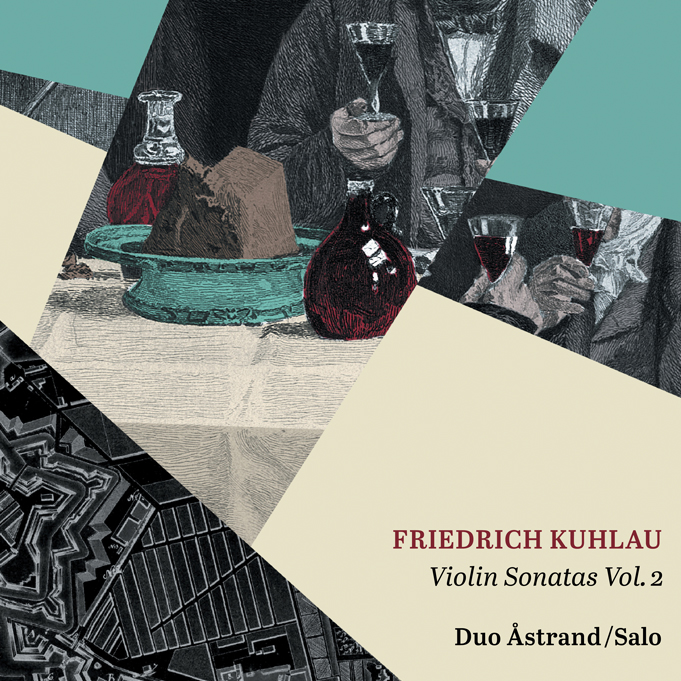
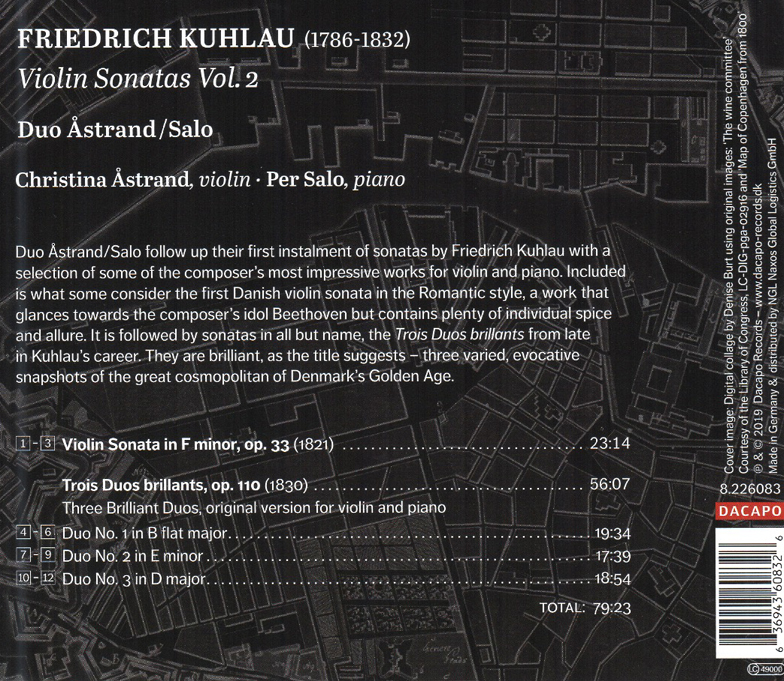
Friedrich Kuhlau Violin Sonatas Vol 2
Sonater opus 33 and 110.
Duo Åstrand/Salo.
Dacapo 2019.
Kuhlau championed new tones in Danish music, and his melodically appealing violin sonatas were the first Danish sonatas in the Romantic style. This cd, containing the last four sonatas, concludes Duo Åstrand/Salo’s complete recording of Kuhlau’s violin sonatas.
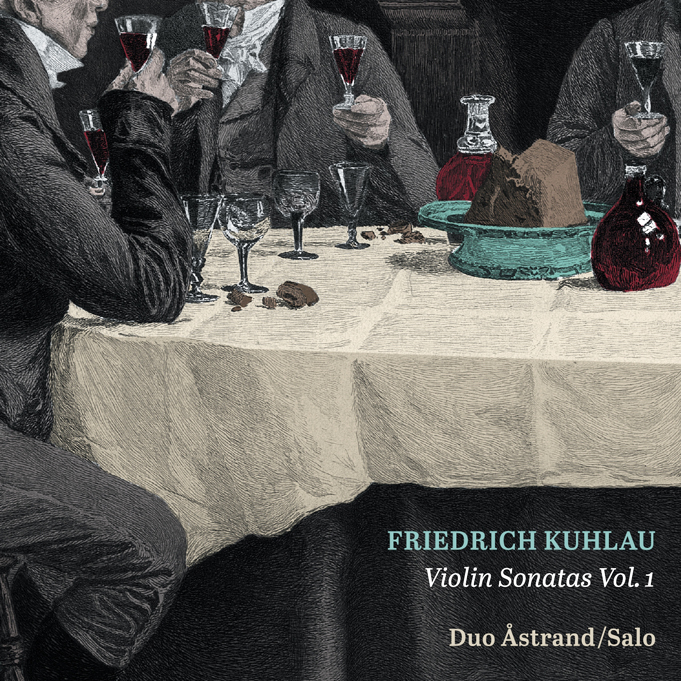
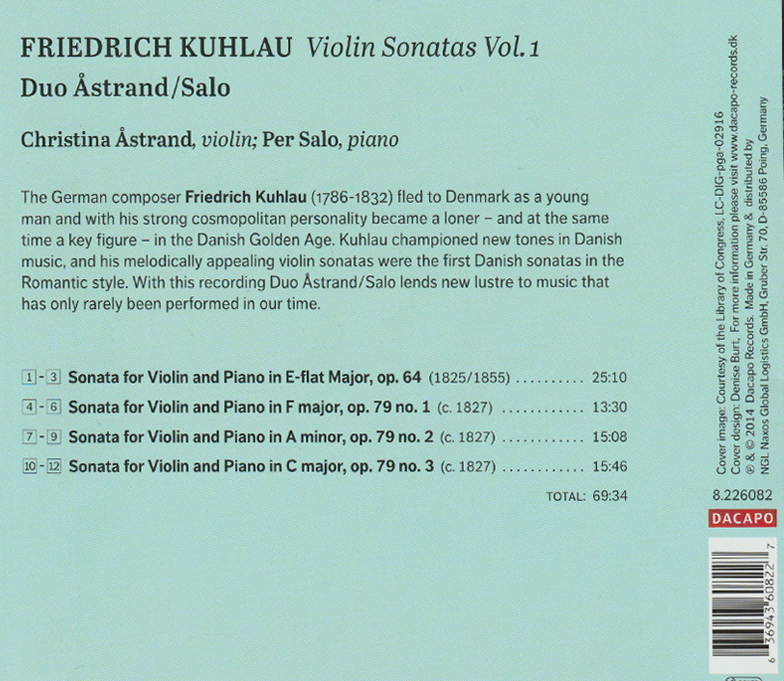
Friedrich Kuhlau Violin Sonatas Vol 1
Sonatas opus 64 and 79.
Duo Åstrand/Salo.
Dacapo 2014.
The German composer Friedrich Kuhlau (1786-1832) fled to Denmark as a young man and with his strong cosmopolitan personality became a loner – and at the same time a key figure – in the Danish Golden Age. Kuhlau championed new tones in Danish music, and his melodically appealing violin sonatas were the first Danish sonatas in the Romantic style. With this recording Duo Åstrand/Salo lends new lustre to music that has only rarely been performed in our time.
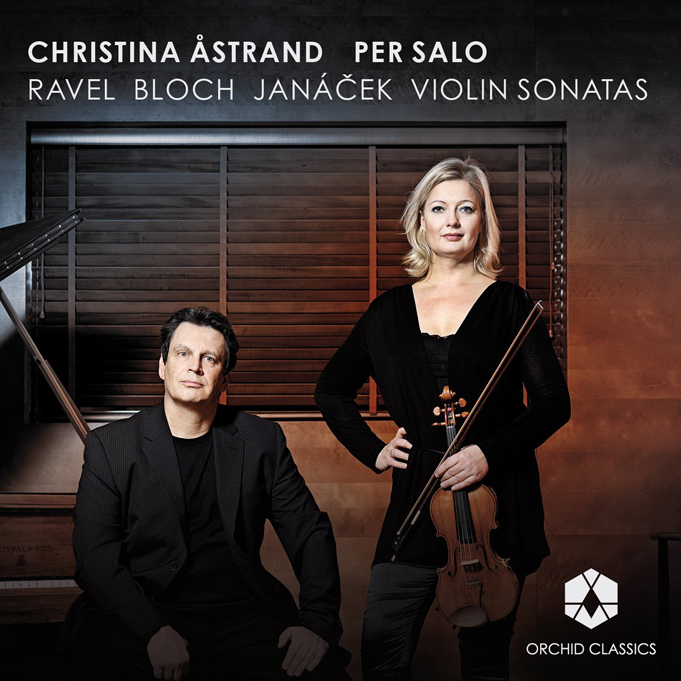
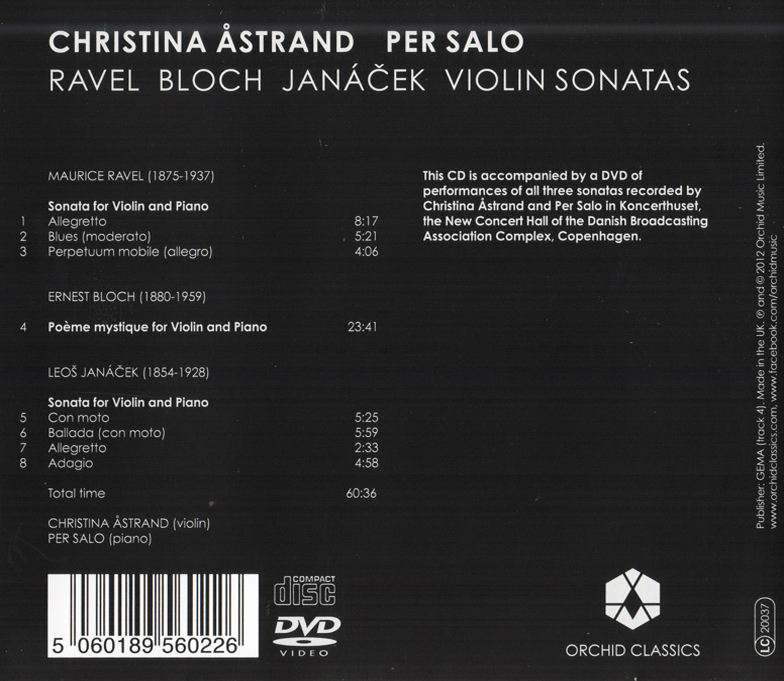
Maurice Ravel - Ernest Bloch - Leos Janacek Violin Sonatas
Duo Åstrand/Salo.
Christina Åstrand, violin. Per Salo, piano.
Orchid 2012.
Three very different violin sonatas are featured on this disc, reflecting the contrasting characteristics and standings of their respective composers. This release even includes a dvd with all three sonatas filmed on the stage of the concert hall in DR-Byen in Copenhagen.
The sonatas were composed almost at the same time – but in three different places in the world at that crucial time between the two World Wars. Ravel’s Sonata was composed in 1923-1927 in Paris, Bloch’s Poème Mystique in 1924 in the United States, and Janácek’s Sonata was written a little earlier in 1914 in Prague but didn’t receive its first performance until 1922.
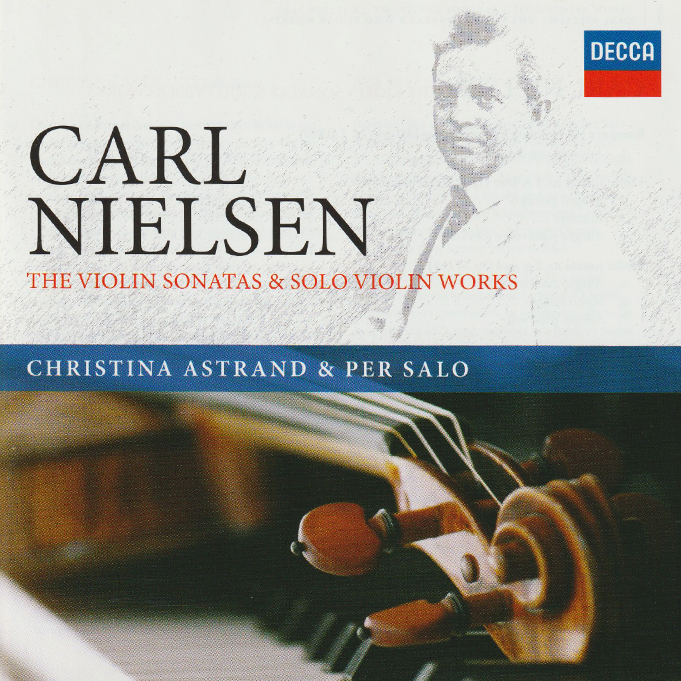
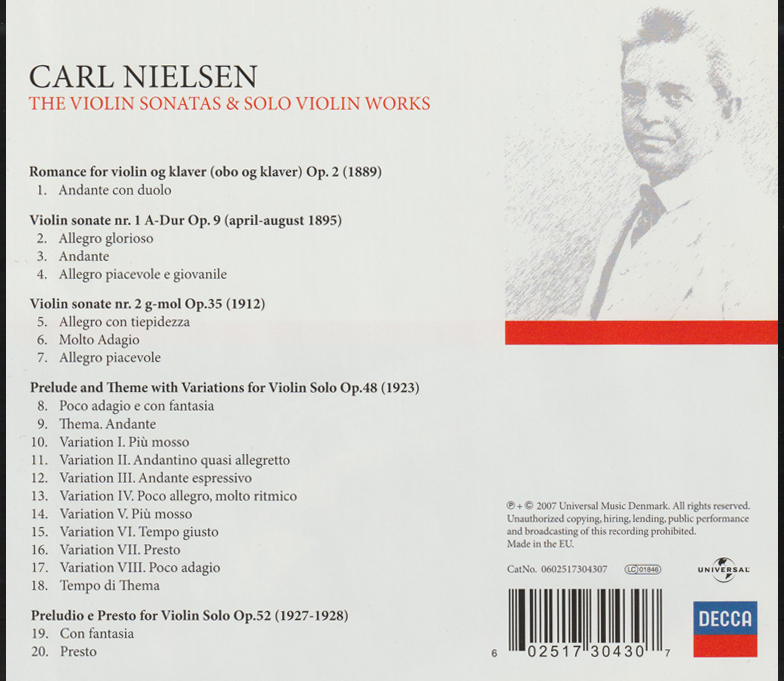
Carl Nielsen the Violin Sonatas & Solo Violin Works
Duo Åstrand/Salo.
Christina Åstrand, violin. Per Salo, piano.
Decca 2007.
The sonatas were met with harsh criticism during Nielsen's time for his rather abrupt and radical key changes, which must have been difficult to digest for audiences at the time. Nowadays, a change from A major to F minor hardly seems shocking; on the contrary, the frequent changes in color keep listeners' interest up throughout the sonatas.
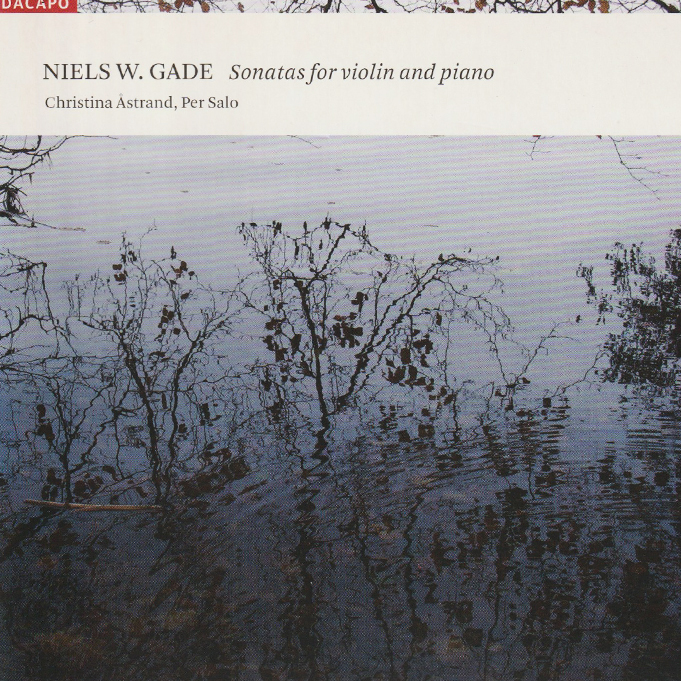
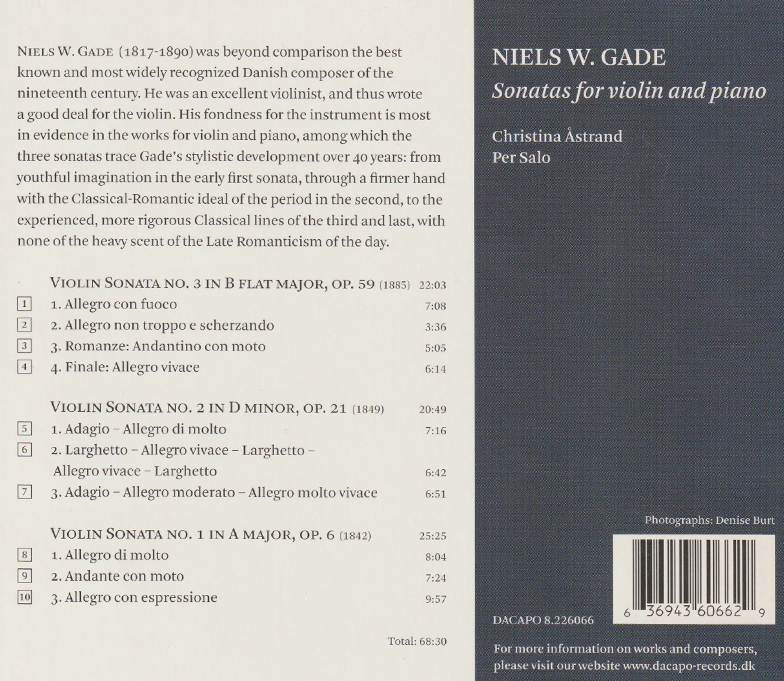
Niels W Gade Violin Sonatas Opus 6, 21 and 59
Duo Åstrand/Salo.
Christina Åstrand, violin.
Per Salo, piano.
Dacapo 2009.
Niels W. Gade (1817-1890) was beyond comparison the best known and most widely recognized Danish composer of the nineteenth century. He was an excellent violinist, and thus wrote many works for the violin. His fondness for the instrument is most in evidence in the works for violin and piano, among which the three sonatas trace Gade's stylistic development over 40 years: from youthful imagination in the early first sonata, through a firmer hand with the Classical-Romantic ideal of the period in the second, to the experienced, more rigorous Classical lines of the third and last, with none of the heavy scent of the Late Romanticism of the day.
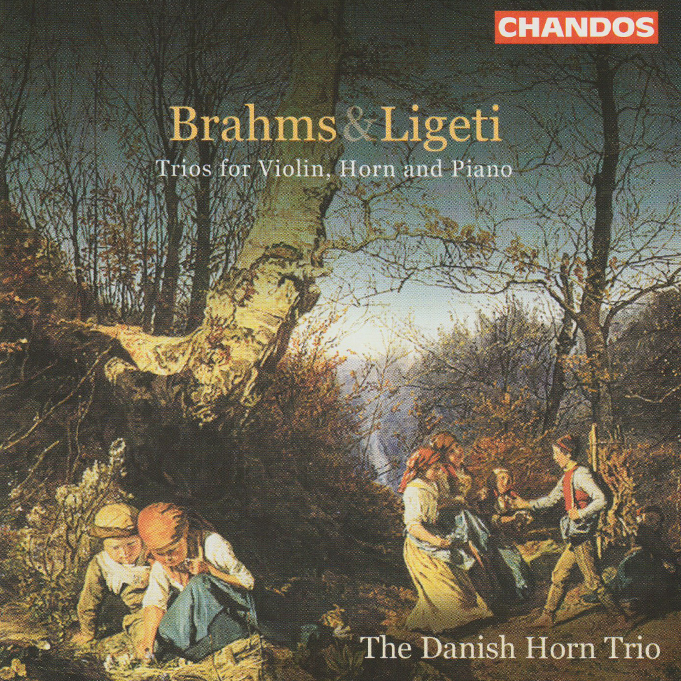
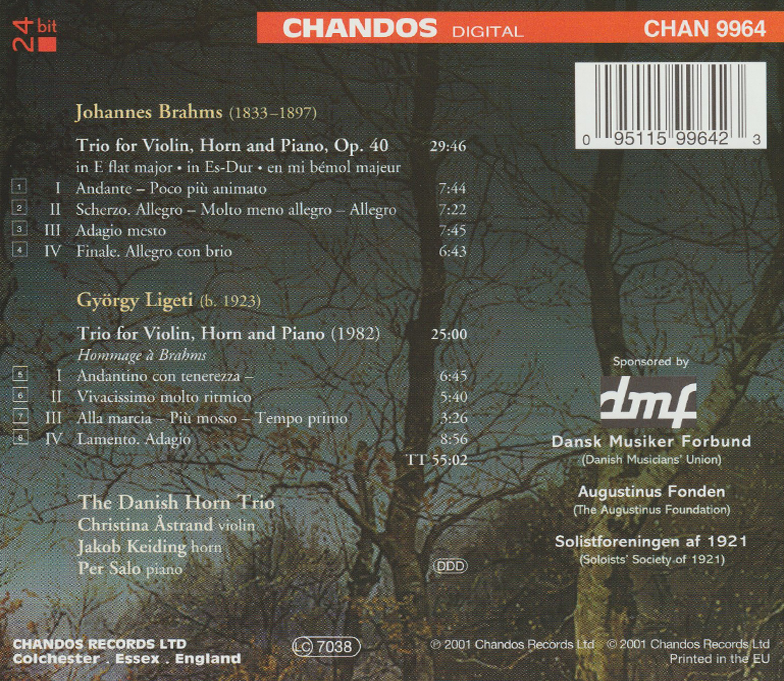
Johannes Brahms Horn Trio Opus 40 György Ligeti: Horn Trio (1982)
The Danish Horntrio.
Chandos 2001.
Brahms’s Trio for Violin, Horn and Piano, Op. 40 (1864–5) was the first significant work for this particular instrumental combination – and, although it has had some distinguished successors, has remained supreme in the genre it established. György Ligeti has called Brahms’s work one which ‘floats in the celestial spheres of the musical heaven as the incomparable example of this category of chamber music’. The very fact that Ligeti felt the urge to enter this category himself suggests the significant position his own Trio (1982) holds in his output. It signals a turn away from his more radically avant-garde music of the previous quarter- century towards a more ‘classical’ approach in which he accepted, though very much on his own terms, traditional genres, more familiar elements of tonality and expressivity, and echoes of Hungarian folk music.
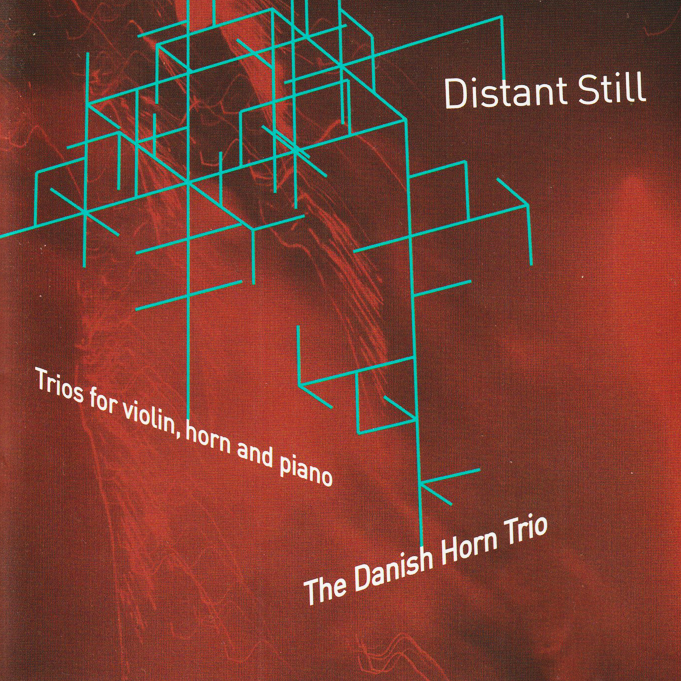
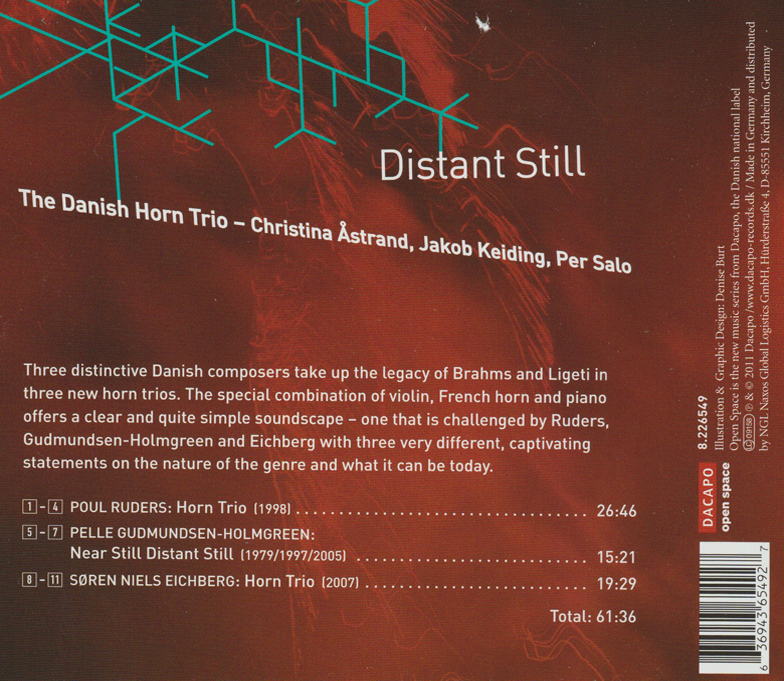
Distant Still Poul Ruders - Søren Nils Eichberg Pelle Gudmundsen-Holmgreen Trios for Violin, Horn and Piano
Christina Åstrand, violin.
Jakob Keiding, horn.
Per Salo, klaver.
Dacapo 2011
The Danish Horn Trio brilliantly displays three of today's leading Danish composers' work with the horn trio phenomenon: Poul Ruders, Pelle Gudmundsen-Holmgreen and Søren Nils Eichberg. All three composers on this CD clearly nod to the genre's legacy by Brahms and Ligeti, and all are profoundly inspired by the transparent soundscape of the three fundamentally different instruments - one bowed, one blown and one struck. However, there are no direct lines connecting the three composers. Each is a distinctive artist who likes to speak with a clear, assured voice - in his own mother tongue. Thus the horn trio becomes a medium through which we can sense varied facets of Danish and international musical history.
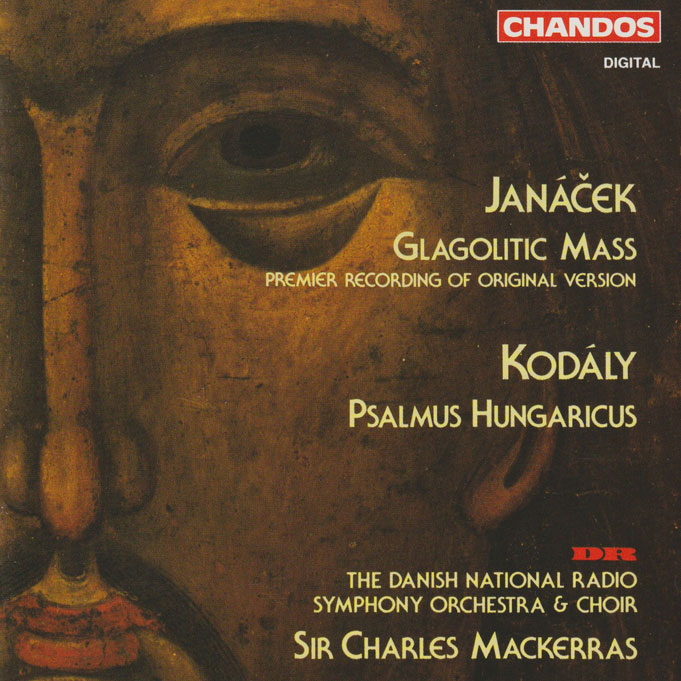
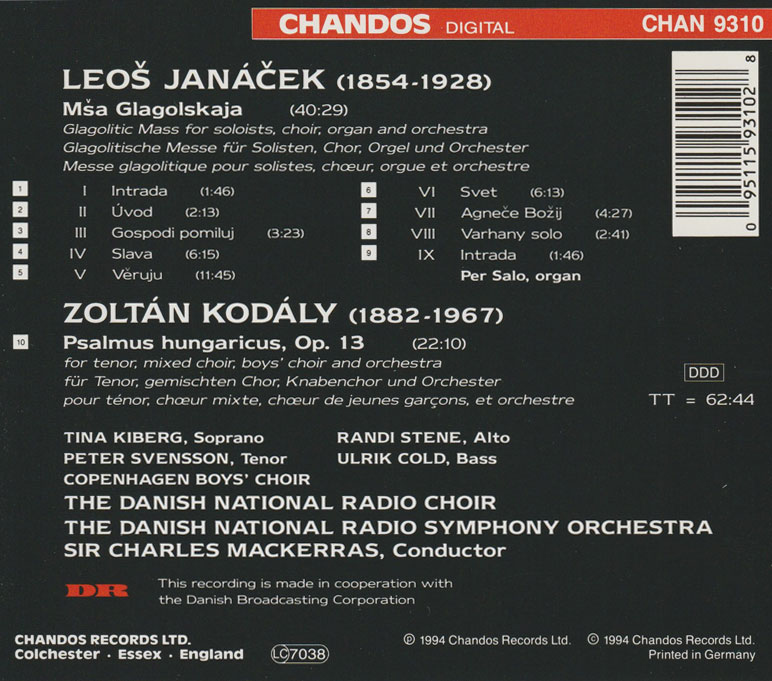
Leos Janácek - Glagolitic Mass Zoltan Kodály - Psalmus Hungaricus
Danish National Symphony Orchestra.
DR Concert Choir, Sir Charles Mackerras.
Organ solo; Per Salo.
Chandos 1994
Two substantial works for orchestra and choir by Czech composer Leos Janácek and Hungarian composer Zoltan Kodály. The virtuoso organ solo in Glagolitic Mass is played by Per Salo on the Marcussen organ of the old concert hall of Danish Radio’s Radiohuset.
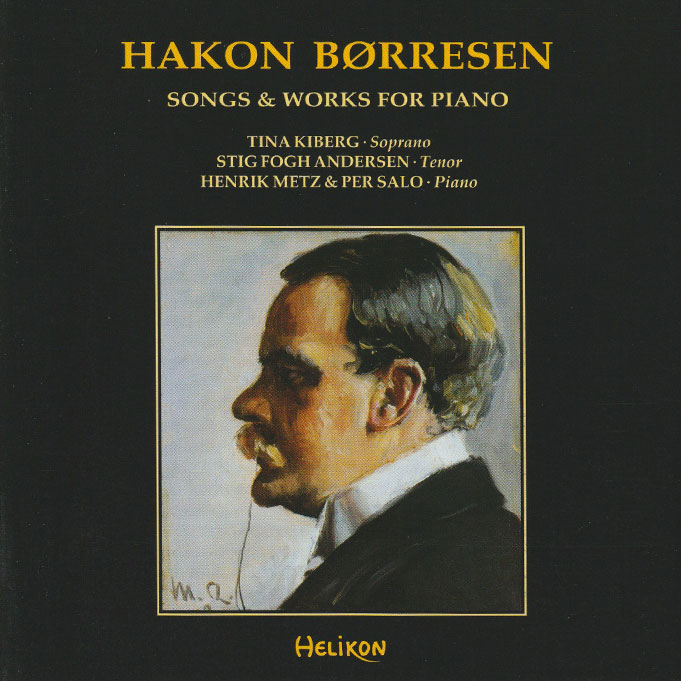
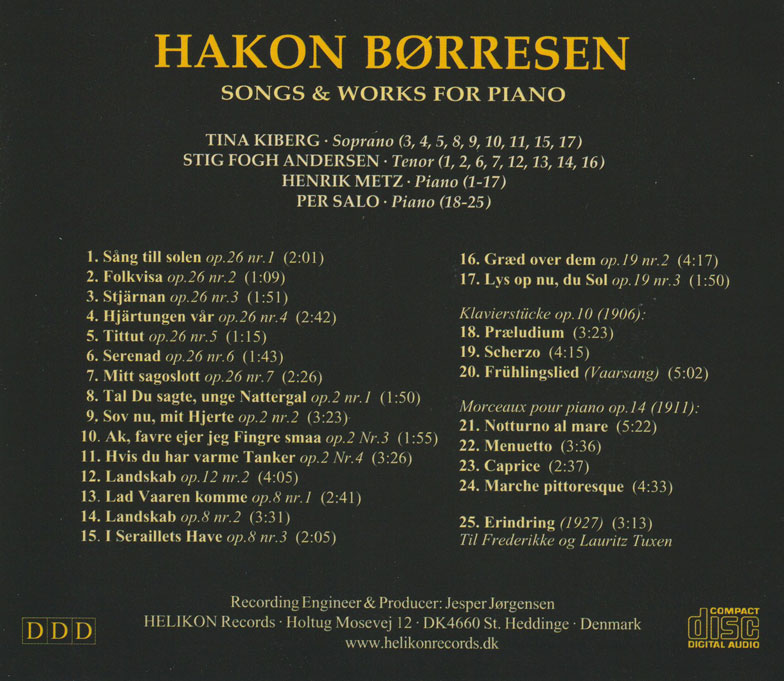
Hakon Børresen Songs & Piano Works
Piano works: Per Salo.
Songs: Tina Kiberg and Stig Fogh Andersen.
Henrik Metz, piano.
Helikon 2003
Hakon Børresen (1876-1954) was a prominent personality in Danish musical life throughout the first half of this century and achieved considerable succes as a composer. His strength as a composer was a well developed ability to write good melodies and a technical mastery of the art of composition. He was dominated by the Danish/Norwegian romantic tradition and throughout his life he remained loyal to the ideals of romantic music - unaffected by the modern currents that so strongly influenced the early 20th century, in Denmark especially by Carl Nielsen. This cd offers for the first time a complete collection of Børresens piano pieces.
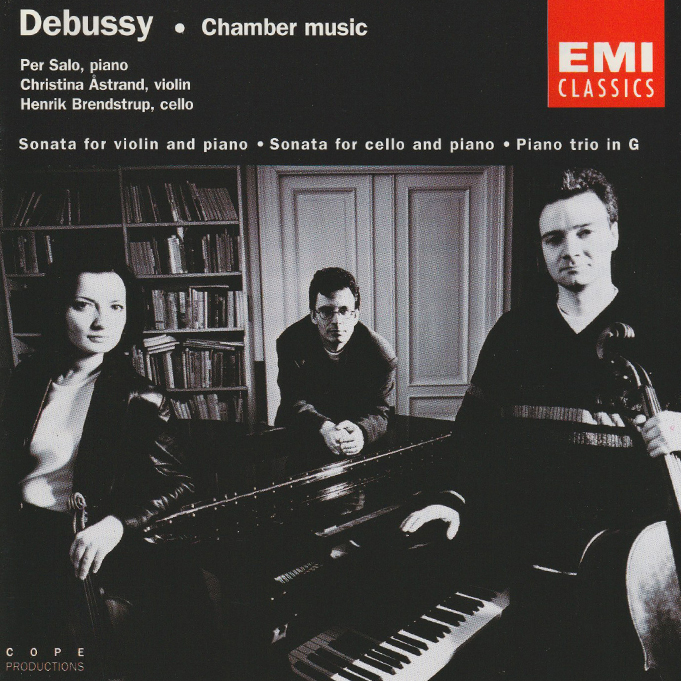
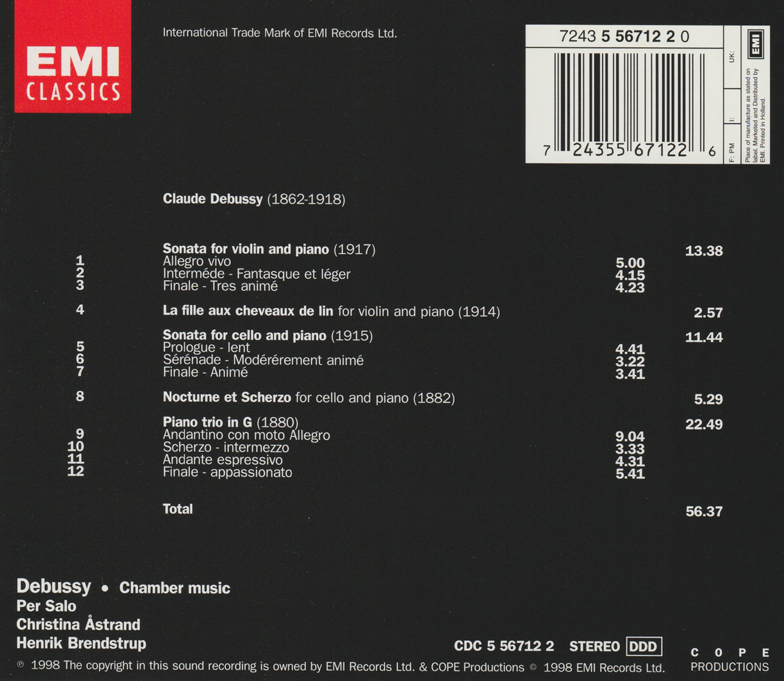
Claude Debussy Violin Sonata, Cello Sonata, Piano Trio
Christina Åstrand, violin.
Per Salo, piano.
Henrik Brendstrup, cello.
EMI Classics 1998
Chamber music forms only a minute part of Claude Debussy´s collected work. For the genre he only composed eight works which illustrate none the less, and despite the paucity in number, the development in his tonal language in a fascinating way.
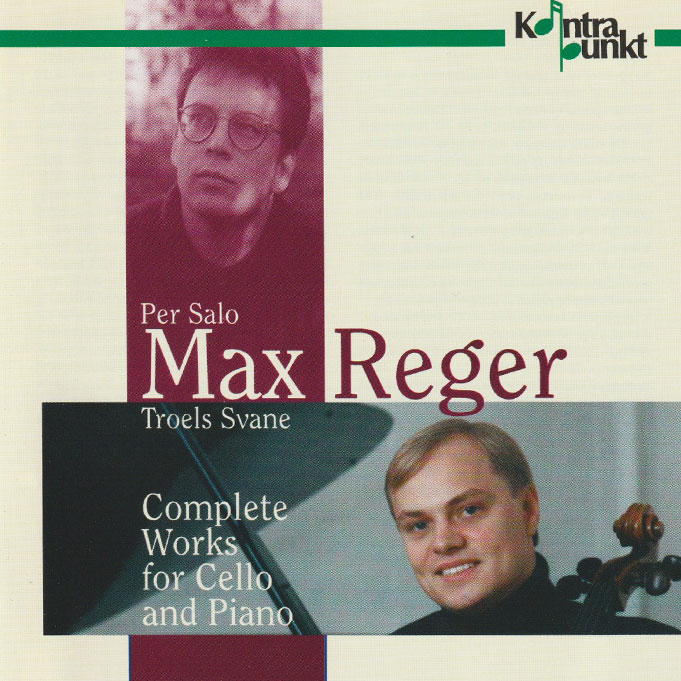
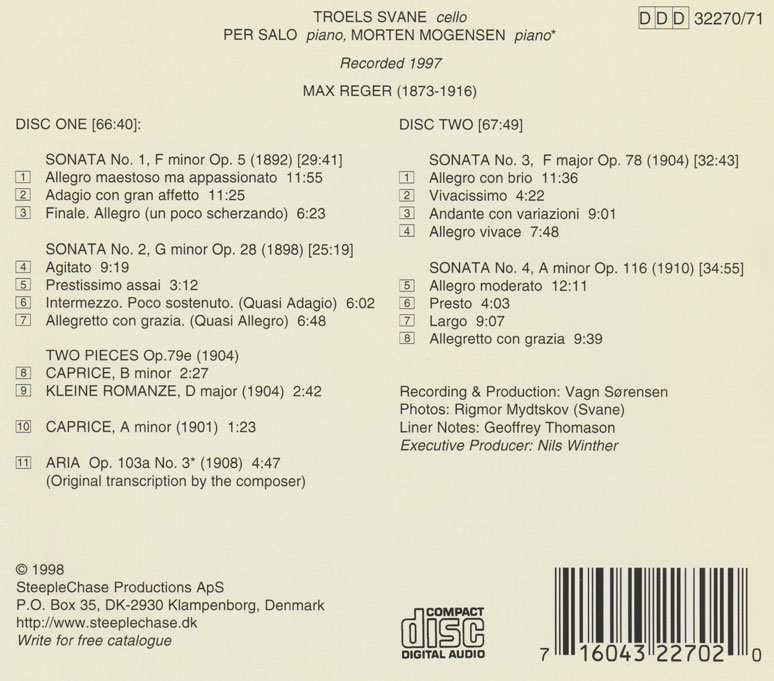
Max Reger Complete Works for Cello and Piano
Troels Svane, Cello.
Per Salo, piano
Kontrapunkt 1998
A complete recording of Reger’s almost forgotten sonatas for cello and piano. Like his contemporary Arnold Schönberg, Max Reger felt the tension between the loyalty towards the great German tradition of tonal music and the need to look forward. While Schönberg finally completely dissolved tonality in his works Reger continued to adhere to the romantic tonal way of composing stretching the tonality to an absolute extreme. In the cello sonatas he furthermore sticks to the rather rigid traditional sonata form which sometime seems about to burst under the burden of his wildly modulating harmonic writing.
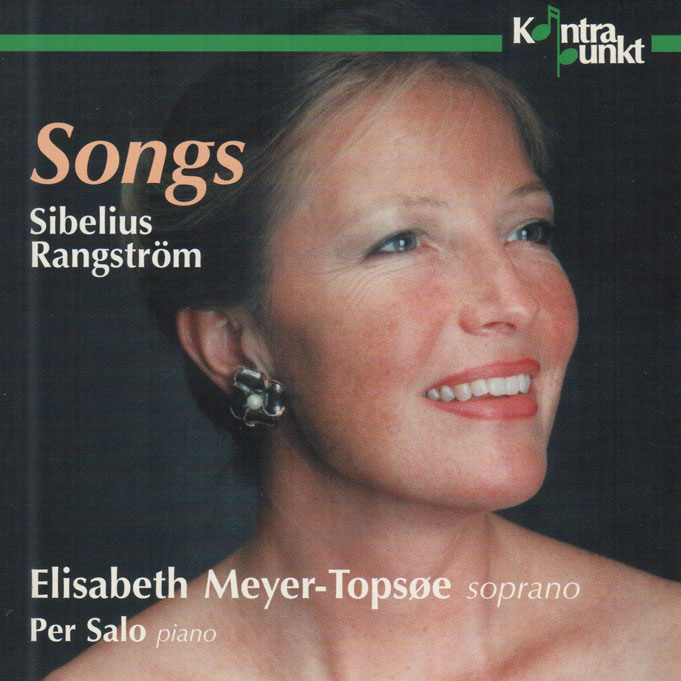
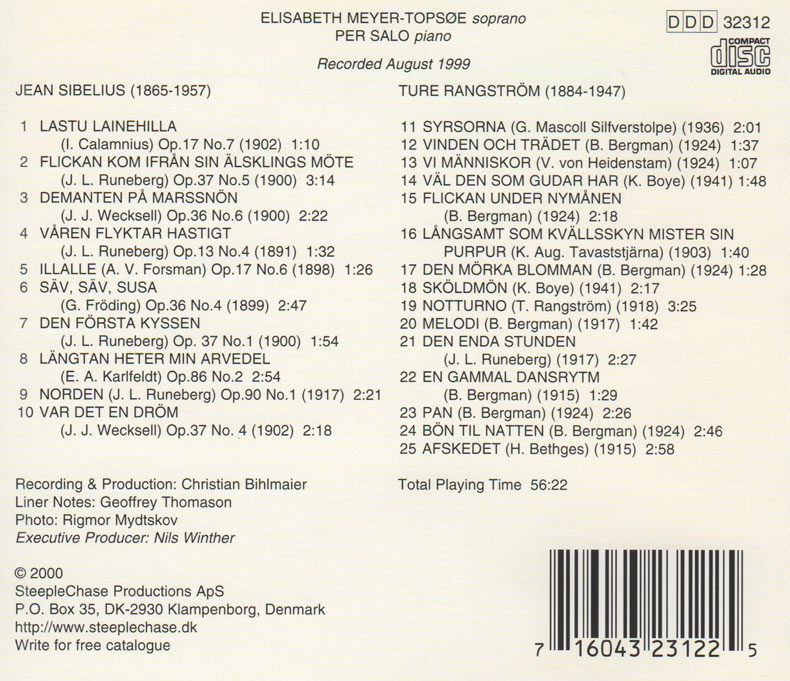
Jean Sibelius - Ture Rangström Songs and Lieder
Elisabeth Meyer-Topsøe,
Per Salo
Kontrapunkt 1999
Finnish Jean Sibelius and Swedish Ture Rangström can both be considered conservative romantic composers and yet each has a very unique Nordic style. In Sibelius’ music one hears the harsh and empty Finnish landscape, in Rangström’s music you will find traces of Swedish folk music. However both composers share the same sense of melancholy and used the song fortheir most personal expression.
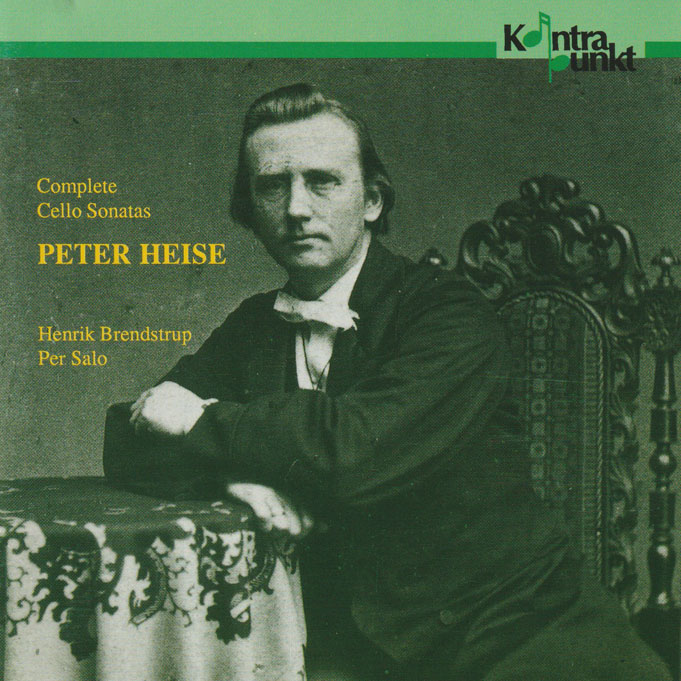
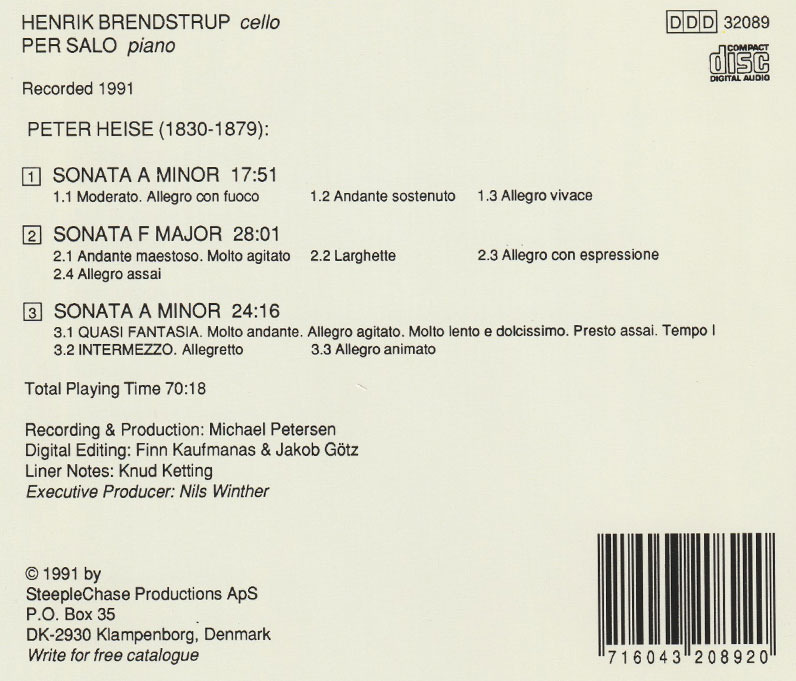
Peter Heise Complete Cello Sonatas
Henrik Brendstrup, Cello.
Per Salo, piano
Kontrapunkt 1991
In Danmark Peter Heise is primarily remembered for his songs and for his opera King and Lord Marshall. He studied with A.P. Berggreen and N.W. Gade. Heise’s bad health brought him to Italy where he spent many periods of his life in Rome. Most probably his cello sonatas were written for Italian cellist Ferdinando Furino and pianist Giovanni Sgambati whom Heise met during a number of stays in Rome.
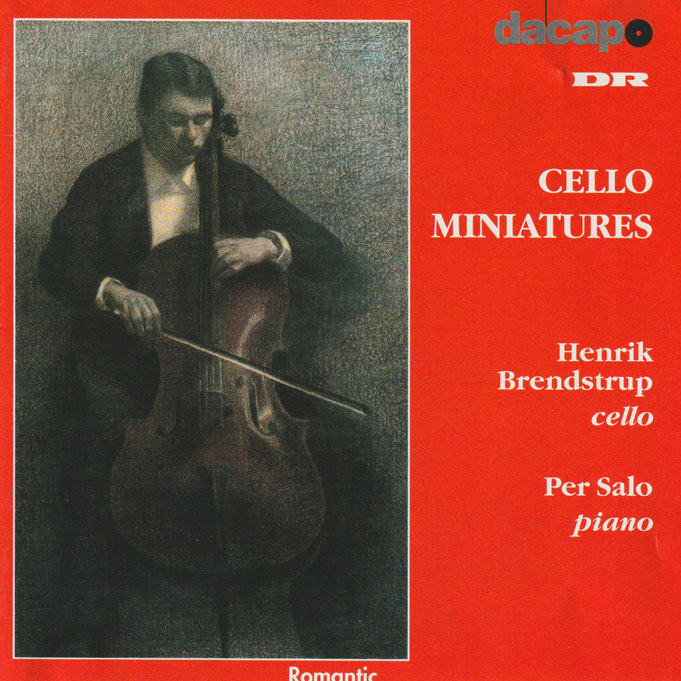
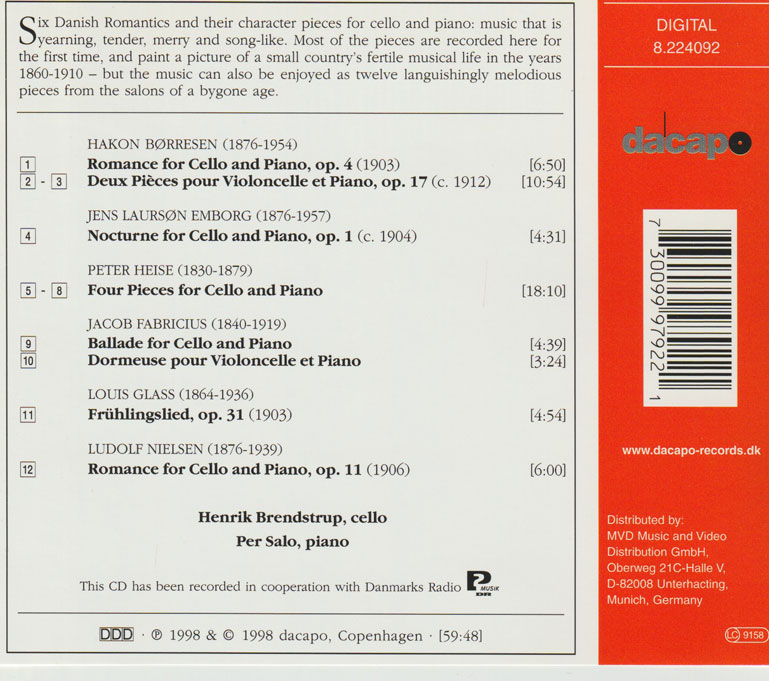
Character Pieces for Cello Børresen - Emborg - Heise Fabricius - Glass - Nielsen
Henrik Brendstrup, Cello.
Per Salo, piano
DaCapo 1998
A nice selection of character pieces for cello and piano written by Danish romantic composers. Beautifully performed by Henrik Brendstrup and Per Salo.
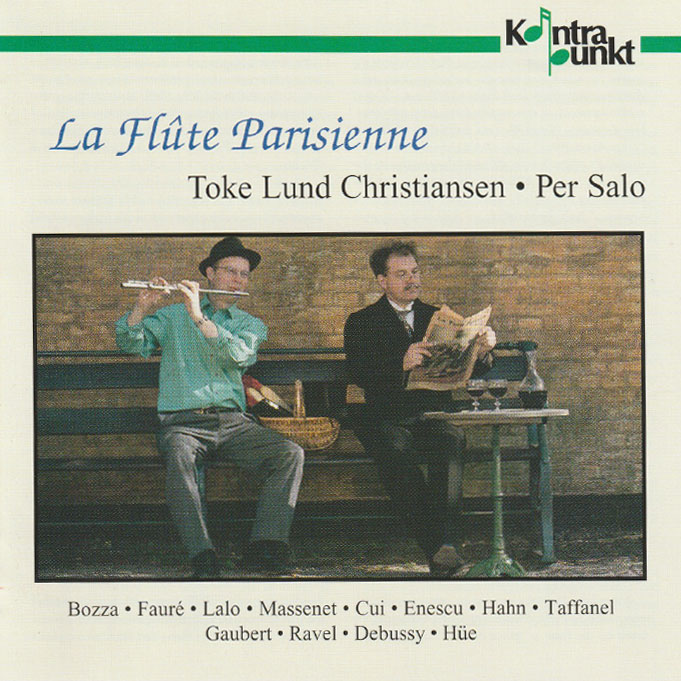
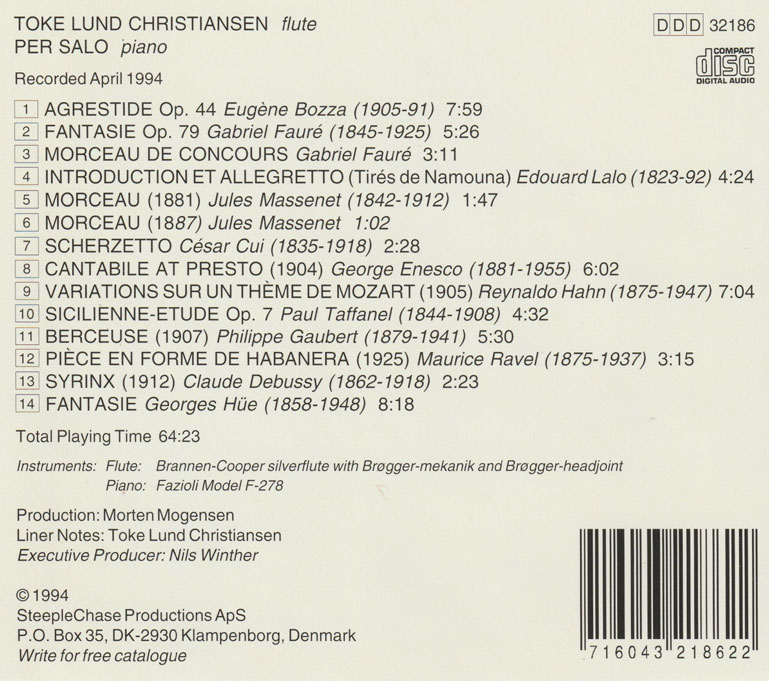
La Flûte Parisienne
Toke Lund Christiansen, flute.
Per Salo, piano
Kontrapunkt 1994
On this recording Toke Lund Christiansen and Per Salo present some of the French core repertoire for flute and piano. The cd contains music by a o Gabriel Faure, Claude Debussy, Maurice Ravel and Paul Taffanel.
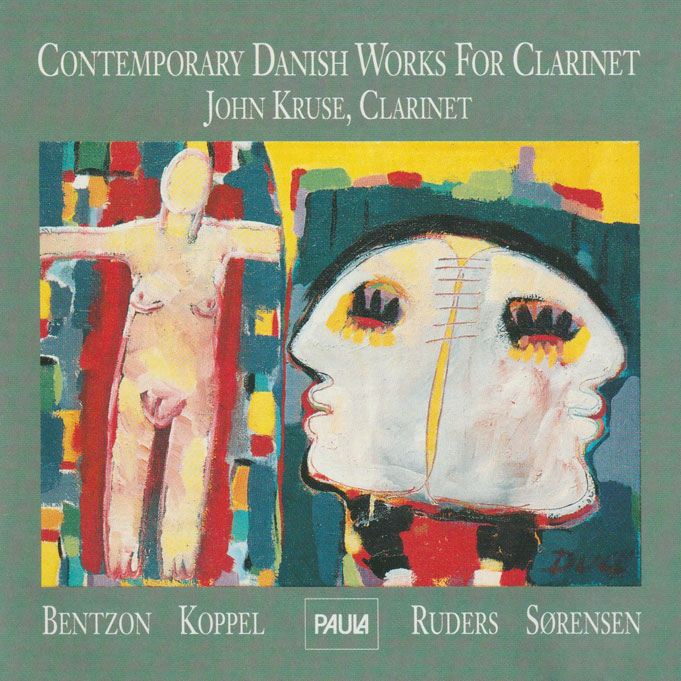
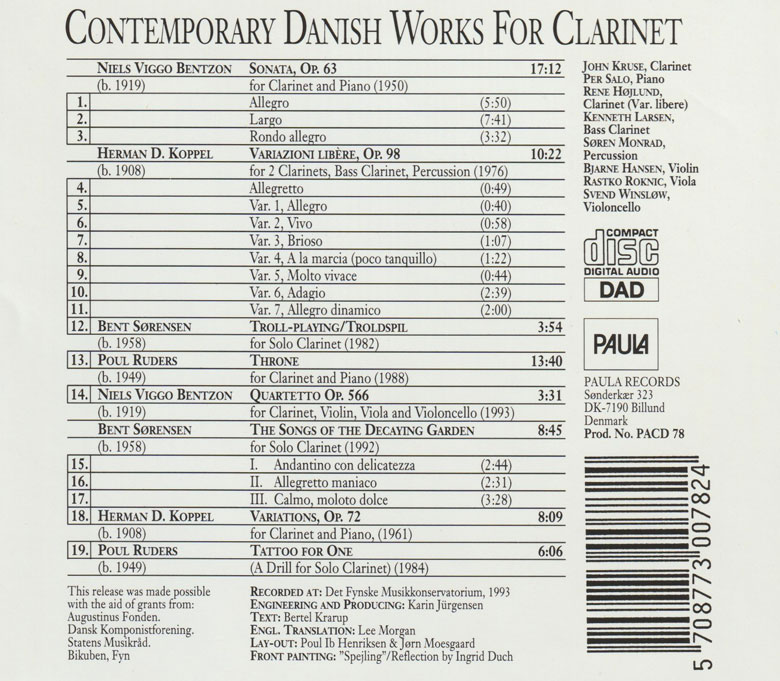
Contemporary Danish Works for Clarinet and Piano
John kruse, Clarinet.
Per Salo, piano
PAULA 1993
Two generations of contemporary Danish composers are presented on this cd featuring music for clarinet and piano. The older generation is represented by Herman D. Koppel (1908-98) and Niels Viggo Bentzon (1919-2000) - the junger generation is represented by Poul Ruders (1949 -) and Bent Sørensen (1958 -).
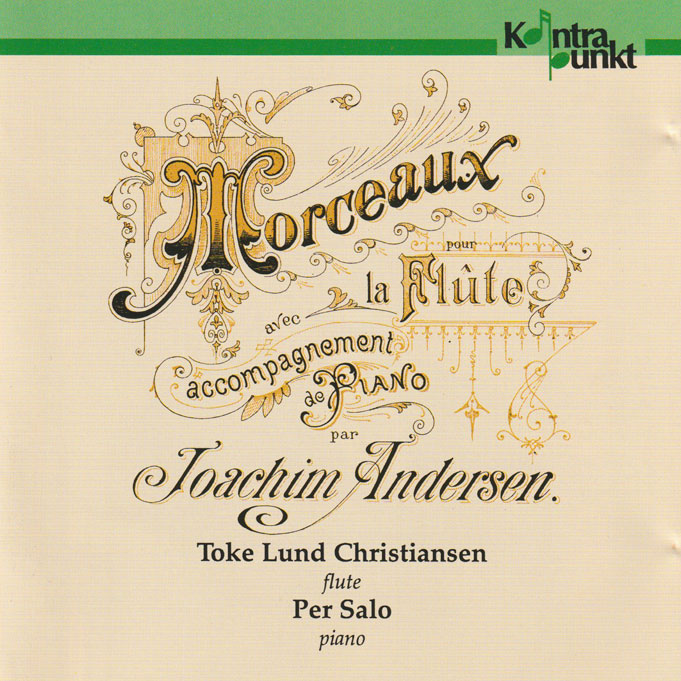
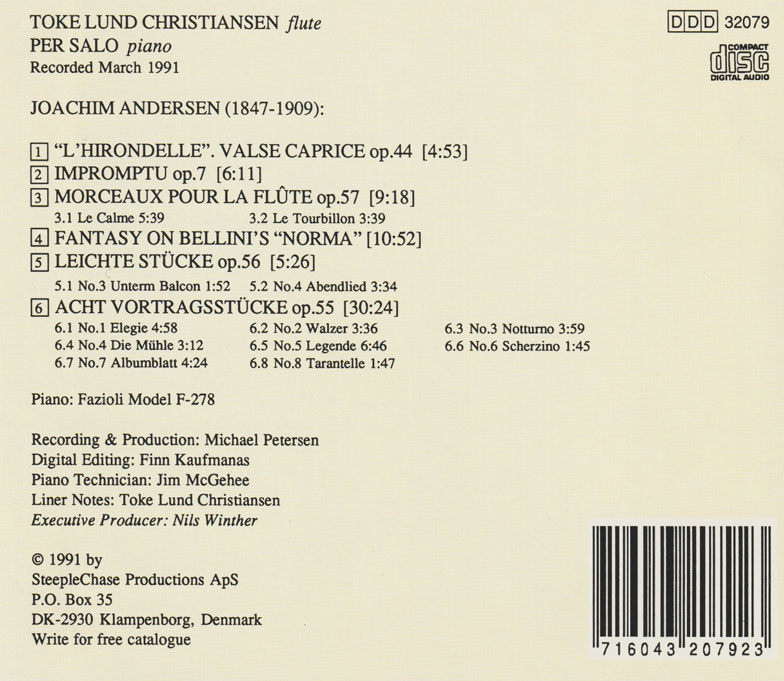
Joachim Andersen Morceaux Pour Flûte Et Piano
Toke Lund Christiansen, flute.
Per Salo, piano
Kontrapunkt 1991
In his own time Joachim Andersen (1847-1909) was an important figure in the central European musical life; co-founder, solo flutist and second conductor of the Berlin Philharmonic, a friend of Tjaikowski, Rubinstein and Hans von Bülow, and known in Paris as The Chopin of the Flute. On this cd a number of his beautiful and melodic pieces can be enjoyed.